SACRED COWS AND HINDUISM
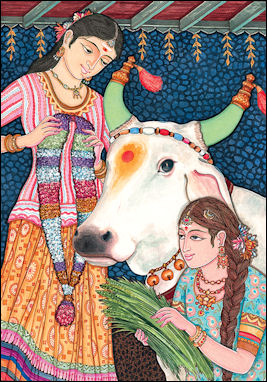
The cow is considered sacred in the Hindu religion — and not just the cow itself but everything that come out of it is sacred as well. Milk, urine, curds, dung and butter from cows, Hindus believe, will cleanse the body and purify the soul. Even the dust of footprints of cows has religious meaning. Hindu livestock has entered in the English language in the form of the expression of shock (“Holy cow!”) and to describe something that is preserved at great length for no rational reason (“sacred cows”).
Veneration for the cow has come to be intimately associated with all orthodox Hindu sects. Because the cow is regarded as the symbol of motherhood and fruitfulness, the killing of a cow, even accidentally, is regarded as one of the most serious of religious transgressions.*
Hindus believe that each cow contains 330 million gods and goddesses. Krishna, the god of mercy and childhood, was a cowherd and a divine charioteer. At festivals honoring Krishna priests shape cow dung into images of the god. Shiva, the god of revenge, rode through heaven on a bull named Nandi and image of Nandi marks the entrance to Shiva temples. [Source: “Cows, Pigs, Wars and Witches” by Marvin Harris, Vintage Books, 1974]
India is home to more cattle than any other country. But cows are not the only things that are sacred. Monkeys are also revered and not killed because of their association with the Hindu god Hanuman. The same also true with cobras and other snakes that appear in a number of sacred contexts such as the bed that Vishnu is sleeps on before creation. Even plants, particularly lotuses, pipal and banyan trees and basil plants (associated with Vishnu), are loved and a great effort is made not to harm them in any way.
Websites and Resources on Hinduism: Hinduism Today hinduismtoday.com ; India Divine indiadivine.org ; Wikipedia article Wikipedia ; Oxford center of Hindu Studies ochs.org.uk ; Hindu Website hinduwebsite.com/hinduindex ; Hindu Gallery hindugallery.com ; Encyclopædia Britannica Online article britannica.com ; International Encyclopedia of Philosophy iep.utm.edu/hindu ; The Hindu Religion, Swami Vivekananda (1894), .wikisource.org ; Journal of Hindu Studies, Oxford University Press academic.oup.com/jhs
Hindu Love of Sacred Cows
Hindus love their cows so much priests are called in to bless newborn calves and calendars picture the faces of beautiful women on the bodies of white cows. Cows are allowed to wander around pretty much wherever they like. People are expected to avoid them rather than visa versa. Police round up ill bovines and let graze on grass near their stations. Retirement homes have even been set up for aging cows.
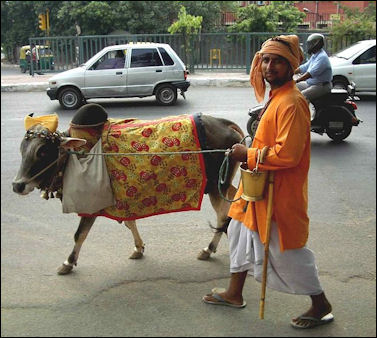
Cow on Delhi street Cows are routinely decorated with garlands of orange marigolds placed around their necks and silver jewelry fitted around their legs. Some cows wear strings of blue beads and small brass bells to "make them look beautiful." Hindu devotees are periodically anointed with a holy mixture of milk, curds, butter, urine and dung. Their bodies are oiled with clarified butter.
A son’s most sacred obligation is to his mother. This notion is embodied in the sacred cow, which is worshiped “like” a mother. Gandhi once wrote: "the cow is a poem of pity. Protection of the cow means protection of the whole dumb creation of God." Sometimes it seems that life of cow is more valuable than human life. Murderers sometimes get off with lighter sentences than someone who accidently kills a cow. One religious figure suggested having all he cows designated to be destroyed be airlifted to India instead. The expense for such an effort is quite high for a country where children die everyday from diseases that could be prevented or cured with cheap drugs.
Hindus spoil their cows. They give them pet names. During the Pongal festival, which celebrates the rice harvest in southern India, cows are honored with special foods. "The cows at Varanasi station are wise to the place," says Theroux." "They get water at the drinking fountains, food near the refreshment stalls, shelter along the platforms and exercise beside the tracks. They also know how to use the crossover bridges and climb up and down the steepest stairs." Cow catchers in India refer to fences to prevent cows from entering stations. [Source: Paul Theroux, National Geographic June 1984]
Reasons for the Hindu Love of Cows
The reverence of cows is tied in with the Hindu precept of “ahimsa”, the belief that it is a sin to harm any living creature because all life forms, from bacteria to blue whales, are also seen as manifestations of the unity of God. The cow is also revered as a symbol of the Mother Goddess. Bulls are great revered but not as sacred as cows.
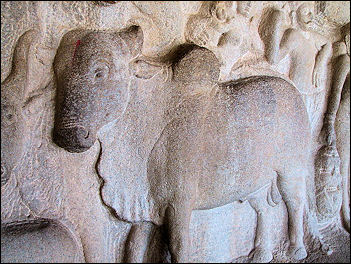
Cow bas relief in Mamallapuram “Hindus venerate cows because cows are the symbol of everything that is alive," wrote Columbia anthropologist Marvin Harris. "As Mary is to Christians the mother of God, the cow to Hindus is the mother of life. So there is no greater sacrifice for a Hindu than killing a cow. Even the taking of a human life lacks the symbolic meaning, the unutterable defilement, that is evoked by cow slaughter."
In “Man on Earth” John Reader wrote: “Hindu theology says 86 reincarnations are needed to transform the soul of a devil into the soul of a cow. One more, and the soul takes on a human form, but killing a cow sends the soul all the way back to the form a devil again...The priests say to look after a cow is in itself a form of worship. People..put them in special sanctuaries when they are too old or sick to be kept at home. At the moment of death, devout Hindus themselves are anxious to hold the tail of a cow, in the belief that the animal will guide them safely to the next life. [“Man on Earth” by John Reader, Perennial Library, Harper and Row.]
Hindu Prohibition of Eating Beef
There are strict taboos concerning the killing cows and the eating of meat in Hinduism and in India. Many Westerners have a hard fathoming why cattle are not slaughtered for food in a country were hunger is an everyday concern for millions of people. Many Hindus say they would rather starve than harm a cow.
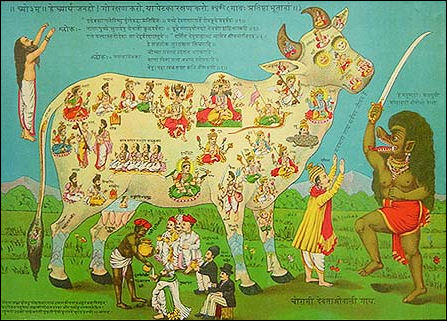
"It seem probable that the sense of unutterable profanity elicited by cow slaughter has its roots in the excruciating contradiction between immediate needs and long-run conditions of survival, "wrote Columbia University anthropologist Marvin Harris, ""During droughts and famines, farmers are severely tempted to kill or sell their livestock. Those who succumb to this temptation seal their doom, even if they survive the drought, for when the rain come, they will be unable to plow their fields."
Beef is occasionally consumed by Muslims and Christians and even sometimes by Hindus, Sikhs and Parsis. Muslims and Christians have traditionally not eaten beef out of respect to Hindus, which in turn have traditionally not eaten pork out respect to Muslims. Sometimes when a severe famine occurs Hindus do resort to eating cows. In 1967 the New York Times reported, "Hindus facing starvation in the drought-stricken area of Bihar are slaughtering cows and eating the meat even though the animals are sacred to the Hindu religion."
A large portion of the meat of cattle that die naturally is eaten by "Untouchables;" other animals end up in Muslim or Christian slaughterhouses. Lower Hindu castes, Christians, Muslim and animists consume an estimated 25 millions bovines that die each year and make leather out of their hide.
Origin of Cow Worship in India
No one is exactly sure when the custom of cow worship became widely practiced. A line in a poem from A.D. 350 mentions "worshiping cows with sandal paste and garlands." An inscription dating back to A.D. 465 equates killing a cow with killing a Brahmin. At this time in history, Hindu royalty also bathed, pampered, and placed garlands on their elephants and horses.

4000-year old Indus seal Cattle have been important in South Asia for a long time. Images of cows painted in the late stone age appear on the walls of caves in central India. People in the ancient Indus city of Harappa yoked cattle to plows and carts and carved images of cattle on their seals.
Some scholars have suggested that the word “cow” is a metaphor in the Vedics for the poetry for the Brahmin priests. When a Vedic poet exclaims: “Don’t kill the innocent cow? he means “don’t write abominable poetry.” Over time, the scholars say, the verse were taken literally
The taboo on eating beef began in earnest around A.D. 500 when religious texts began associating it with the lowest castes. Some scholars have suggested custom may have coincided with the expansion of agriculture when cows became important plowing animals. Other have suggested the taboo was linked with beliefs about reincarnations and the sanctity of life of animals, particularly cows.
Ancient Cow Eating in India
According to Vedic texts, cattle was regularly eaten in India during the early, middle and late Vedic periods. According to historian Om Prakash, author “Food and Drinks in Ancient India”, oxen and barren cows were offered at rituals and eaten by priests; cows were eaten at marriage feasts; slaughterhouses existed; and the flesh of horses, rams, buffalo and probably birds were all eaten. In the later Vedic period, he wrote, oxen, big goats, and sterile cows were slaughtered and cows, sheep, goats and horses were offered as sacrifices.
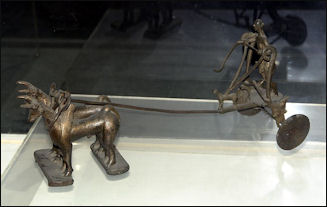
4500-year-old Indus Valley bullock cart The Ramayana and the Mahabharata have references to beef eating. There is also plenty of evidence — cattle bones with human teeth marks — from archeological digs. One religious text referred to beef as “the best kind of food” and quoted a 6th century B.C. Hindu sage as saying, “Some people do not eat cow meat. I do so, provided it’s tender.” The Mahabharata describes one king who was famous for slaughtering 2,000 cows a day and distributing meat and grain to Brahmin priests.
See Aryan, Sacrifices
In 2002, Dwijendra Narayan Jha, a historian at the University of Delhi, caused a big uproar when he asserted in his scholarly work, “Holy Cow: Beef in Indian Dietary Traditions” that ancient Hindus ate beef. After excerpts were released on the Internet and published in an Indian newspaper, his work was called “sheer blasphemy” by the World Hindu Council, copies were burned in front of his house, his publishers stopped printing the book and Jha had to be taken to work under the protection of police. Academics were surprised by the brouhaha. They saw the work as a simple historical survey that rehashed material that scholars had known for centuries.
Reasons for Hindu Cow Worship
Harris believed that the custom of cow worship came about as an excuse not to provide meat at feasts and religious ceremonies. "Brahmins and their secular overlords found it increasingly difficult to satisfy the popular demand for animal flesh," Harris wrote. "As a result, meat eating became the privilege of a select group...while the common peasants...had no choice but to preserve their own domestic stock for traction, milk and dung production."
Harris believes that in the middle of the first millennium B.C., Brahmins and other members of the upper-caste elite ate meat, while members of the lower caste did not. He believes that reforms introduced by Buddhism and Jainism — religions that emphasized the sacredness of all living things — led to the worship of cows and the taboo against beef. Harris believes that the reforms were made at a time when Hinduism and Buddhism competed for the souls of people in India.
Harris says that the beef taboo may not have completely taken hold until the Muslim invasion of India, when the practice of not eating beef became of way of distinguishing Hindus from beef-eating Muslims. Harris also asserts that the worship of cows became more widely practiced after population pressures made severe droughts especially hard to endure.
"As population density grew," Harris wrote, "farms became increasingly smaller and only the most essential domesticated species could be allowed to share the land. Cattle were the one species that could not be eliminated. They were the animals that drew the plows upon which the entire cycle of rainfall agriculture depended." Oxen had to be kept to pull the plows and a cow was needed to produce more cattle."Cattle thus became the central focus of the religious taboo on meat eating...The conversion of beef into forbidden flesh originated in the practical life of individual farmers."
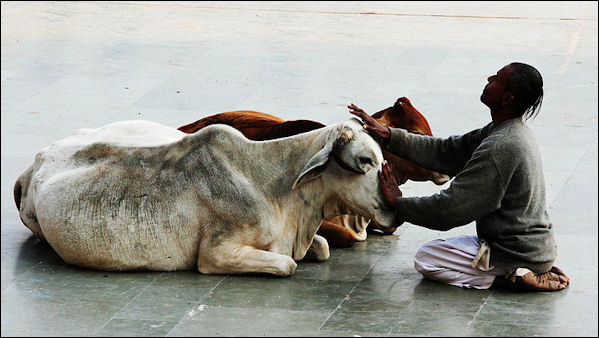
cow stroker
Theory Behind the Sacred Cows and Hinduism
In a paper entitled the “Cultural Ecology of Indian's Sacred Cow” Harris suggested that the Hindu attitude toward cattle must have evolved for some practical ecological reason. He studied areas where cattle roamed about aimlessly and areas where there were no cattle and found out that people were much better off with cattle than without them. ["Man on Earth" by John Reader, Perennial Library, Harper and Row.]
Even though Hindus do not use cattle as a source of meat, the animals do provide milk, fuel, fertilizer, plowing power, and more cows and oxen. Zebu cattle require little maintenance and the don't use up land that could be used to grow crops. They are resourceful scavengers that get most of their food from grass, weeds or garbage that are used by humans.
According to one study in West Bengal, most of the food consumed by milk-producing cattle was waste from human products like rice straw, wheat bran and rice husks. According to the scientist who conducted the study, "Basically, the cattle convert items of little direct human value into products of immediate utility."
Poor farmers can afford to utilize sacred cows or bulls because they primarily feed off land and scraps that don't belong to the farmer. If the farmer kept the cow on his own property the grazing land utilized by the cow would seriously eat into the land the farmer needs to raise crops to feed his family. Many of the "stray" cattle have owners who let them loose during the day to scavenge for food and are brought into homes at night to be milked. Indians like to purchase their milk straight from the cow. That way they are sure its fresh and not mixed with water or urine.
Sacred Cows as a Source of Food and Plowing Animals
Harris found that even though the average milk production of a cow was low they still supplied 46.7 percent of the nation's dairy production (with buffalo supplying most of the remainder). They also ironically provided the country with a large portion of it meat. ["Man on Earth" by John Reader, Perennial Library, Harper and Row.]

Cows decorated for Diwali
Hindus consume large amounts milk, buttermilk, and curds. Most Indian dishes are prepared with ghee (clarified) butter, which comes from cows. If cows were slaughtered for meat they would yield much less food over the long run than if were allowed to live and give milk.
Most farmers use hand-wrought ploughs drawn by a pair of oxen or buffalo to break the land. But not every farmer can afford their own draft animals or borrow a pair from a neighbor. So how do farmers without animals prepare their fields? Hand plows are too inefficient and tractors are even more expensive and inaccessible than oxen and buffalo. Many farmers who can’t affore their own animals harness sacred cattle, preferably oxen (bulls), found wandering around near their farms.. Cattle are also widely used to turn wheels that draw water. City cows provide useful function as well. They eat garbage and waste thrown on the streets, pull carts, serve as lawnmowers and provide dung for city people.
The Zebu cattle in India are ideally suited for their role. They can survive on scrub, sparse grass and agricultural waste and ate very hardy and able to survive droughts and high temperatures. See Zebu cattle, Livestock.
Dung and Urine from Sacred Cows
The greatest benefit that bovines provide, said Harris, is fertilizer and fuel. About half of India's population earns less than a $2 a day and they survive primarily on food the grow themselves. On this income, farmers can hardly afford commercial fertilizer or kerosene for stoves. About half of the usable cow dung in India is used as fertilizer; the other is used for fuel. Harris estimated that 340 million tons of nutrient-rich dung fell on farmer's fields in the 1970s and an additional 160 millions fell on waysides scavenged by the cows. Another 300 million tons was collected and used as fuel or building material.

Cowmeenakshi Dung is often collected while it is still steaming and shaped in pancake-like patties, which are dried and stored and later used as cooking fuel. Firewood is in short supply in many areas. One survey found that dung was the sole source of cooking and heating fuel in nine out of ten rural households in the 1970s. Cow dung is often preferred over kerosene because it burns with a clean, slow, long-lasting flame that doesn't overheat the food. Meals are usually cooked over a low heat for hours , which frees women to take care their children, tend their gardens and perform other chores. [Source: "Cows, Pigs, Wars and Witches" by Marvin Harris, Vintage Books, 1974]
Cow dung is also mixed with water to make a paste which is used as flooring material and wall cover. Cow dung is such a prized material that a great efforts is made to collect it. In the countryside women and children are usually responsible for collecting dung; in the cities sweeper castes collect and make a good living selling it to housewives. These days cattle dung is increasingly being used to provide biogas.
Hindu nationalists in India operate a laboratory that is devoted to developing uses of cow urine, much of it from cows “rescued” from Muslim butchers. Pankaj Mishra wrote in the New York Times, “In one room, its white-washed walls spattered with saffron-hued posters of Lord Rama, devout young Hindus stood before test tubes and beakers full of cow urine, distilling the holy liquid to get rid of the foul-smelling ammonia and make it drinkable. In another room tribal women in garishly colored saris sat on the floor before a small hill of white powder, dental powder made from cow urine...The nearest, and probably unwilling, consumers of the various products made from cow urine were the poor tribal students in the primary school next to the lab.”
Hindu nationalists have heralded the patenting of cow urine as a medicine in the United States as proof that traditional Hindu practices are superior to modern medicine, which is only starting to catch up. Cow dung as been used for centuries as a medicine. it is now made into pills.
Image Sources: Wikimedia Commons
Text Sources: “World Religions” edited by Geoffrey Parrinder (Facts on File Publications, New York); “Encyclopedia of the World’s Religions” edited by R.C. Zaehner (Barnes & Noble Books, 1959); “Encyclopedia of the World Cultures: Volume 3 South Asia “ edited by David Levinson (G.K. Hall & Company, New York, 1994); “The Creators” by Daniel Boorstin; “A Guide to Angkor: an Introduction to the Temples” by Dawn Rooney (Asia Book) for Information on temples and architecture. National Geographic, the New York Times, Washington Post, Los Angeles Times, Smithsonian magazine, Times of London, The New Yorker, Time, Newsweek, Reuters, AP, AFP, Lonely Planet Guides, Compton’s Encyclopedia and various books and other publications.
Last updated December 2023
